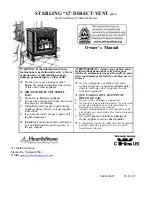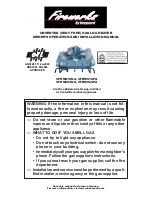
Page 4 of 25
consistent with the temperature rating of the wire being
used. Use minimum 75°C rated wire.
7.
Proper installation of the heater requires that an adequate
grounding conductor be connected to the ground terminal.
This terminal is painted green or marked with the letter
“G” and is located on the inside of the control enclosure
next to the power input opening.
8.
Check and confirm all connections are securely fastened.
9.
Before application of electrical power, check all
connections to ensure compliance with the wiring
diagram and any code requirements. Remove any foreign
objects from the control boxes. Reinstall covers tightly.
10.
On all 3-phase heaters, it is necessary to verify that the
fan is rotating in the proper direction. If air delivery is
not from the front of the heater, exchange any 2 input
wires at the main contactor terminal located in the control
enclosure.
11.
The explosion-proof control box is designed with
threaded joints and metal-to-metal contact at the lid or
cover joint to prevent an explosion. Do not attempt to
install gasket material of any type at these joints. A light
coating of anti-seize compound is applied to the threads to
prevent seizing.
12.
See section titled “operation” before energizing the
heater.
D.
Field Installed Controls:
1.
Power Disconnect Switch:
The NEC requires that a power disconnect switch be
mounted within sight of the heater. The CEC or local
codes may require a disconnect switch within sight of the
heater. Refer to the electrical diagram and follow these
steps:
a.)
The remote power disconnect switch must be an
explosion-proof disconnect switch rated for the area
classification.
b.)
The switch must be indicating and have a locked off
position.
c.)
The switch must be rated for the nameplate voltage
and current per the NEC, CEC and any local codes.
d.)
Follow steps 6 through 12 of the electrical
installation instructions to complete the installation.
2.
Room Thermostat:
Refer to the electrical wiring diagram and follow these
steps:
a.)
Connect the remote thermostat across the leads
marked “C” and “C1”. The external thermostat will
then be in series with the heater thermal high-limit
switches and correct operation of the heater will
result.
b.)
The wiring to the remote thermostat must be copper
wire, 16 gauge minimum (for Class II) or 14 gauge
minimum (Class I) and run in explosion-proof
conduit with appropriate conduit seals installed per
the NEC, CEC and any local codes.
c.)
Any room thermostat used with this heater must be of
an explosion-proof type rated for the area
classification, open on temperature rise, rated
250VAC, 75VA inductive capacity.
3.
‘Fan Only’ Switch:
Refer to the electrical wiring diagram and follow these
steps:
a.)
Do not attempt to install a “Fan Only” switch on a
standard unit heater and do not try to field modify a
standard unit heater for this option. The heater must
have been ordered for this option to have the
necessary internal controls.
b.)
Connect the remote ‘fan only’ selector switch across
the leads marked “C” and “F".
c.)
The wiring to the fan selector switch must be copper
wire, 16 gauge minimum (for Class II) or 14 gauge
minimum (for Class I) and run in explosion-proof
conduit with appropriate conduit seals installed per
the NEC, CEC and any local codes.
d.)
Any selector switch used with this heater must be an
explosion-proof switch rated for the area
classification, maintained 2 position selector switch
rated for 250 VAC, 75 VA inductive.
OPERATION
The unit heater may be operated normally at ambient
temperatures of 104°F (40°C) or less and at altitudes of 3,300
feet (1000m) or less in atmospheres containing less than 21%
oxygen by volume, and as classified on the nameplate. All of
these conditions must be met before attempting to operate the
heater. The heater should never be operated in an oxygen-
enriched atmosphere or at ambient temperatures above 104°F,
(40°C). The heater may be operated at higher altitudes if the
ambient temperatures are below 104°F, (40°C).
A.
Initial Operation:
Check to make sure the mechanical and electrical installation
is complete and that it is safe to operate the heater.
1.)
Heater without built on or remotely mounted fan
switch:
a.)
Set the temperature control thermostat to a
setting above the current room temperature.
b.)
Energize the heater electrical supply circuit.
c.)
The heater and fan should come on and in 5 to 15
minutes reach a stable operating temperature. If
the room temperature is high and the installation
is above 3,300 feet, the unit heater may cycle on
the thermal high limits of the motor or the heater.
d.)
Check out and report any unusual or
questionable operating characteristics, such as
noise, vibration, loss of fluid, etc. Note that
crackling noises coming from the heat exchanger
during warm up are normal.
e.)
Set the temperature control thermostat to the
desired room temperature setting.
f.)
De-energize the heater electrical supply circuit
until heater operation is required.
2.)
Heater with fan switch:
a.)
Place the fan switch in the fan position.
b.)
Set the temperature control thermostat to a
setting below the current room temperature.
c.)
Energize the heater electrical supply circuit.
d.)
The heater fan should come on but the heater
should remain off.
































